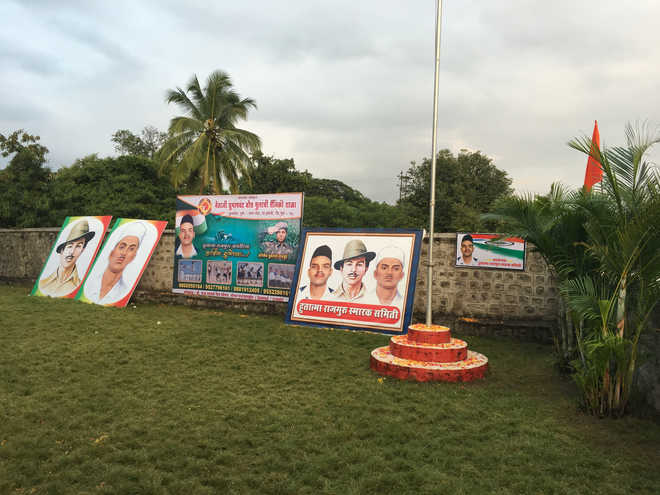
Photos by the writer
Dr Jagdish Chander
I recently had a chance to visit AFMC, Pune, for some official work for a full one-week. In the mid-week, it was August 24 and I had a cherished dream since long to visit the house of martyr Shivram Hari Rajguru. So I planned a programme along with two of my colleagues to visit Khed town (Maharashtra), the birthplace of Rajguru. Now, the town is renamed as Rajgurunagnar to honour the revolutionary icon of the freedom struggle of India. It is located about 45 kilometers north of Pune on the Pune-Nashik main highway road.
On reaching Rajgurunager, at the right side of the main crossing in the town, the statue of the martyr is installed, which had garlanding in the morning as a token of his birthday. I had only seen the Rajguru Market during my college period in Hisar (now in Haryana), which was named after the martyr in 1953 and no other monument is seen except the joint statue of the three martyrs. Rajguru was born on August 24, 1908 and got his martyrdom on March 23, 1931, along with Bhagat Singh and Sukhdev at the hands of British Empire in the Central Jail, Lahore, now in Pakistan. Therefore, most of the people of this town place wreaths, flowers and all sorts of respect to the martyr on both these days in the mornings. They hoist the national flag in the morning at the birthplace of Rajguru, which is inside the town at the bank of Bhima River. All walks of people come to pay their respect to the martyr throughout the day. In the evening around 6.00PM, the flag hoisting ceremony is closed. Since I had gone from Chandigarh, this time they got it done from me and I had honour to close down the same.
All the functions are organized under the banner of Martyr Rajguru Memorial Committee, which keeps all sorts of activities going on at his birthplace. They have collected meager among of token funds from the local people and maintaining it for many years. They do not take bulk cash but ask any volunteer to provide the material services. When the house was in a very bad shape, somebody made the walls, the other provided the cemented work. Hence at present a house structure isstanding at the original site of the birthplace of Rajguru. There is a small statue at the birthplace also for garlanding and placing the wreaths and flower by the visitors. At the entry room, on one corner they have placed the sand taken from Hussaniwala (Punjab), where these three martyrs were cut into pieces by the British and burnt unceremonial at the bank of Sutlej river on the night of 23rd March 1931, after finishing the hanging.
Every year on 23rd March, the Martyr Rajguru Memorial Committee, organizes a visit to Hussaniwala and about 125-150 persons visit there and pay their respect to all the three martyrs.They organize competition essays about the life of martyr on 24th August as well as 23rd March in the schools and give prizes to the outstanding students. A Ranogli contest is also organized at the birthplace of Rajguru where the school students show their talent of making Rangoli in such a way as if it is the painting of Rajguru and looks so natural.
They maintain a visitors’ register for writing the comments and people have written their feelings to the martyr. Various people coming from different parts of India pay respect here and write some comments. In the house itself photographs of almost all the leading personalities actively involved in the freedom struggle are permanently displayed. These are martyrs like Kartar Singh Sarabha, Khudiram Bose, Chandershekar Azad, Bhagat Singh, Sukhdev and many others. A brief sketch of their lives is also given in Marathi as well as English language along the sides of the portraits. After going though all the displayed portraits, the life sketch of Rajguru is summarized as how he left this place to go to Varanasi (Benares) in his late teens. He came in contact with the members of Hindustan Socialist RepublicAssociation, which was further renamed“Army” by replacing the word “Association”. Inqualab Zindabad (Long Live -Revolution) was their theme motive. Chandershekher in the pseudo-name as “Balraj” was its ‘Commander-in-Chief. Rajguru had joined the HSRA and it was the decision of the organization to avenge the martyrdom of Lala Lajpat Rai to kill the police official, J. P. Saunders, responsible for his death, wherein Rajguru fired the first shot, followed by Bhagat Singh and the defence line by Chandershekher. While fleeing from Lahore, Rajguru became the “servant” of the first class married passenger, Bhagat Singh, hoodwinking the entire police force. Such a wide and elaborative description is not found even in books as it is displayed there.
It was a nice experience to see all the original thighs belonging to one of the martyr of our uncompromising struggle of freedom movement.
The writer is professor & head, department of microbiology, Government Medical College Hospital, Sector 32, Chandigarh



























